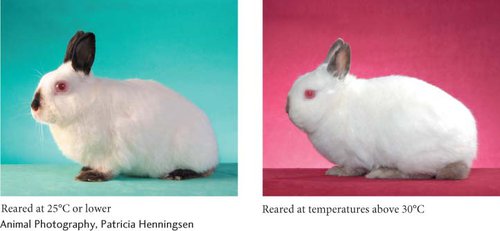Environmental Effects on the Phenotype
The phenotypic expression of some genotypes critically depends on the presence of a specific environment. For example, the himalayan allele in rabbits produces dark fur at the extremities of the body—on the nose, ears, and feet (Figure 4.23). The dark pigment develops, however, only when the rabbit is reared at a temperature of 25°C or less; if a Himalayan rabbit is reared at 30°C, no dark patches develop. The expression of the himalayan allele is thus temperature dependent; an enzyme necessary for the production of dark pigment is inactivated at higher temperatures. The pigment is restricted to the nose, feet, and ears of a Himalayan rabbit because the animal’s core body temperature is normally above 25°C and the enzyme is functional only in the cells of the relatively cool extremities. The himalayan allele is an example of a temperature-sensitive allele, an allele whose product is functional only at certain temperatures.

4.23 The expression of the himalayan allele depends on the temperature at which a rabbit is reared. The rabbit on the left was reared at temperatures below 25°C; the rabbit on the right was reared at temperatures above 30°C.
[Animal Photography, Patricia Henningsen.]
Environmental factors also play an important role in the expression of a number of human genetic diseases. Glucose-6-phosphate dehydrogenase is an enzyme that helps to supply energy to the cell. In humans, there are a number of genetic variants of glucose-6-phosphate dehydrogenase, some of which destroy red blood cells when the body is stressed by infection or by the ingestion of certain drugs or foods. The symptoms of the genetic disease, called glucose-6-phosphate dehydrogenase deficiency, appear only in the presence of these specific environmental factors.
Page 104
These examples illustrate the point that genes and their products do not act in isolation; rather, they frequently interact with environmental factors. Occasionally, environmental factors alone can produce a phenotype that is the same as the phenotype produced by a genotype; such a phenotype is called a phenocopy. In fruit flies, for example, the autosomal recessive mutation eyeless produces greatly reduced eyes. The eyeless phenotype can also be produced by exposing the larvae of normal flies to sodium metaborate.
CONCEPTS
The expression of many genes is modified by the environment. A phenocopy is a trait produced by environmental effects that mimics the phenotype produced by a genotype.
